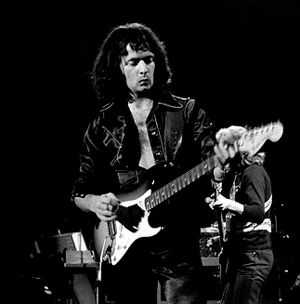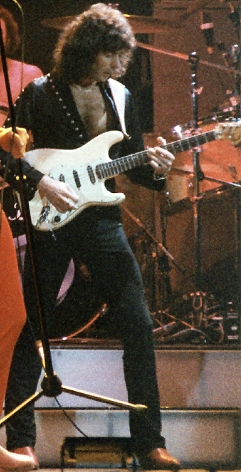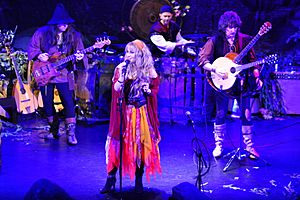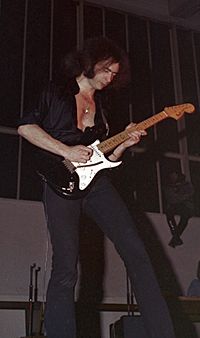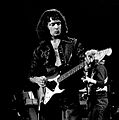Ritchie Blackmore facts for kids
Quick facts for kids
Ritchie Blackmore
|
|
|---|---|
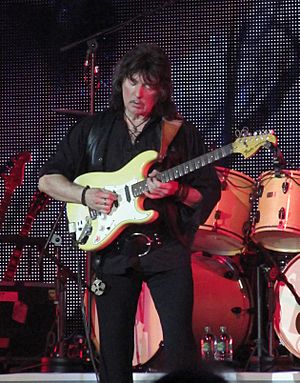
Blackmore performing in 2017
|
|
| Background information | |
| Birth name | Richard Hugh Blackmore |
| Also known as | The Man in Black |
| Born | 14 April 1945 Weston-super-Mare, Somerset, England |
| Origin | Heston, Middlesex, England |
| Genres | |
| Occupations |
|
| Instruments | Guitar |
| Years active | 1960–present |
Richard Hugh Blackmore (born 14 April 1945) is an English guitarist. He was a founding member and the guitarist of Deep Purple. This band helped create hard rock music.
After leaving Deep Purple in 1975, Blackmore started the band Rainbow. This group mixed hard rock with sounds from baroque music. Over time, Rainbow's music became more like catchy pop-style mainstream rock. Rainbow broke up in 1984, and Blackmore rejoined Deep Purple until 1993. In 1997, he formed the folk rock band Blackmore's Night with his wife, Candice Night.
Blackmore is known for creating many famous guitar riffs. He plays solos that are influenced by both classical music and blues. As a member of Deep Purple, Blackmore was added to the Rock and Roll Hall of Fame in April 2016. Many music magazines, like Guitar World and Rolling Stone, say he is one of the greatest and most important guitar players ever.
Contents
Early Life and Music Beginnings
Blackmore was born in Weston-super-Mare, England. His family moved to Heston, Middlesex, when he was two. When he was 11, his father gave him his first guitar. He had to promise to learn how to play it well. He took classical guitar lessons for one year.
Blackmore left school at age 15. He started working as an apprentice radio mechanic at Heathrow Airport. He also took electric guitar lessons from a professional guitarist named Big Jim Sullivan.
Music Career Highlights
Starting Out in the 1960s
In 1960, Ritchie Blackmore began working as a "session player." This means he played guitar for other musicians' recordings. He also played in several bands. He was first a member of the Outlaws, an instrumental band. They played in studios and live concerts. He also played for singers like Glenda Collins and Heinz.
In late 1967, Blackmore joined a new band called Roundabout. He was invited by Chris Curtis. After the band's members were complete in April 1968, Blackmore suggested the new name Deep Purple. It was his grandmother's favorite song. Deep Purple's early sound was a mix of psychedelic rock and progressive rock. This first version of Deep Purple made three albums.
Deep Purple and Rainbow in the 1970s
Deep Purple's second album, In Rock (1970), changed the band's sound. It moved from progressive rock to hard rock. This version of the band, with singer Ian Gillan and bassist Roger Glover, lasted until 1973. They made four studio albums, and two of them reached number one in the UK. The band's songs often came from their jam sessions.
Blackmore later said, "I didn't care about song construction. I just wanted to make as much noise and play as fast and as loud as possible." Guitarist Steve Vai praised Blackmore's ideas, saying he "was able to bring blues to rock playing unlike anybody else."
Blackmore left Deep Purple in 1975 to start his own band, Ritchie Blackmore's Rainbow. This band was later just called Rainbow. Their first album, Ritchie Blackmore's Rainbow, came out in 1975. Rainbow's music was inspired by medieval and baroque music. Blackmore even took cello lessons to help with his music ideas. After their second album, Rising (1976), the singer Ronnie James Dio left Rainbow. This was because he and Blackmore had different ideas about the band's direction. Blackmore wanted a more commercial sound.
In 1979, Rainbow released Down To Earth with new singer Graham Bonnet. This album had the band's first top 10 UK hit singles: "Since You Been Gone" and "All Night Long".
Rainbow and Deep Purple in the 1980s
Rainbow's next album, Difficult to Cure (1981), featured singer Joe Lynn Turner. The main song on this album was a rock version of Beethoven's Ninth Symphony. Blackmore said, "I found the blues too limiting, and classical was too disciplined. I was always stuck in a musical no man's land." The band's music became more radio-friendly.
Rainbow released Straight Between the Eyes (1982) and Bent Out of Shape (1983). In 1983, Rainbow was nominated for a Grammy Award for the song "Anybody There." Rainbow broke up in 1984.
In 1984, Blackmore rejoined Deep Purple with the "Mark Two" line-up. They recorded two new albums, Perfect Strangers (1984) and The House of Blue Light (1987).
New Bands and Projects in the 1990s
Deep Purple recorded another album, Slaves and Masters (1990), with former Rainbow singer Joe Lynn Turner. The "Mark Two" line-up of Deep Purple reunited again in 1992 for one more album, The Battle Rages On.... Blackmore left the band for good in November 1993.
Blackmore reformed Rainbow with new members in 1994. This version of Rainbow, with singer Doogie White, lasted until 1997. They released one album called Stranger in Us All in 1995. Rainbow played its last concert in 1997. Blackmore later said, "I didn't want to tour very much."
Rainbow had many different musicians over the years. Blackmore was the only member who stayed from beginning to end. Rainbow sold more than 28 million albums worldwide.
In 1995, Blackmore started a new folk rock project with his girlfriend, Candice Night. This became the band Blackmore's Night. Their first album, Shadow of the Moon, came out in 1997. Blackmore mostly played acoustic guitar to support Night's singing. Their music mixes medieval music with Night's lyrics, which are often about love and medieval times. Their second album, Under a Violet Moon (1999), continued this folk-rock style.
Blackmore's Night and Rainbow Today
In later albums, like Fires at Midnight (2001), Blackmore's Night sometimes used more electric guitar. They released a live album, Past Times with Good Company, in 2002. They also released a Christmas album, Winter Carols, in 2006. Blackmore's Night avoids big rock concert tours. They prefer to play in smaller, more personal venues. As of 2021, Blackmore's Night has released eleven studio albums, with the latest being Nature's Light.
A reformed Rainbow played three concerts in Europe in June 2016. They played songs from both Rainbow and Deep Purple.
Guitar Gear
In the 1960s, Blackmore played a Gibson ES-335 guitar. From 1970 until he formed Blackmore's Night in 1997, he mainly played a Fender Stratocaster. He also used a special guitar neck called a "scalloped" fretboard. This means the wood between the frets is curved out.
Blackmore used different effects with his guitar. These included a treble booster and a modified tape machine for echo and delay. He also used a wah-wah pedal and other effects like a Uni-Vibe and a Dallas Arbiter Fuzz Face. In the 1980s, he experimented with Roland guitar synthesizers.
He tried many different pick-ups in his Stratocasters. Since the early 1990s, he has used Lace Sensor "noiseless" pick-ups.
Musical Influences
Blackmore named Jeff Beck as his favorite guitar player. He also admired Jimi Hendrix, Yes guitarist Steve Howe, and Bob Dylan's guitarist Mike Bloomfield. He said about Beck, "whenever I watch Beck I think 'How the hell is he doing that?'"
Blackmore also said that Eric Clapton's music helped him develop his own guitar style around 1968 or 1969. In 1979, Blackmore mentioned that he liked popular music, including ABBA. He also said, "I think classical music is very good for the soul." He felt it was important to tell young people to "just give classical music a chance."
Blackmore's Guitar Style
Blues and Classical Mix
In his guitar solos, Blackmore mixes blues scales and sounds with ideas from European classical music. He often played with his fingers instead of a pick, sometimes even holding the pick in his mouth.
Classical Music Influence
Blackmore was a pioneer in bringing classical music ideas into rock and roll. He especially liked the Baroque composer Johann Sebastian Bach. For example, he told Guitar World that he used a Bach-like chord progression for the "Highway Star" guitar solo.
Blackmore also used chord progressions called "cycle of 4ths," which were common in Baroque music, especially by Bach. A good example is in the "Burn" guitar solo.
Rhythm Guitar Style
One of Ritchie Blackmore's special skills is writing memorable guitar riffs using 4ths. His most famous riff, the intro to Deep Purple's "Smoke On the Water", is a great example. Other Deep Purple songs like "Mandrake Root" and "Burn" also used this idea. Riffs using 4ths became very popular in hard rock and heavy metal music after Blackmore.
Blackmore often used simple arrangements for the verses of songs. He would play single-note riffs or octaves. This gave more space for keyboard players. "Smoke On the Water" is a perfect example of this technique.
Blackmore was also known for taking musical ideas from other artists. He once said, "I get inspired by other people's songs and write something vaguely similar." For example, the intro riff to "Black Night" was partly inspired by Ricky Nelson's 1962 song "Summertime."
Lead Guitar Techniques
The guitar technique called sweep picking was first used in rock music by Ritchie Blackmore. It can be heard at the end of "April," a song from Deep Purple's album. Blackmore used this technique again in Rainbow's song "Kill the King."
Personal Life
In May 1964, Blackmore married Margit Volkmar from Germany. They lived in Hamburg in the late 1960s. Their son, Jürgen, born in 1964, later played guitar in a tribute band. After their divorce, Blackmore married Bärbel in September 1969. He can speak German fluently.
Blackmore moved to the US in 1974. He listened to a lot of early European classical music and light music during this time. He said, "I listen very carefully to the patterns that Bach plays. I like direct, dramatic music." He married Amy Rothman in 1981, but they divorced in 1983.
Blackmore and Candice Night began living together in 1991. They got married in 2008. Their daughter Autumn was born in 2010, and their son Rory in 2012. Blackmore enjoys watching German television and has a collection of about 2,000 CDs of Renaissance music.
In 2025, Candice Night shared that Blackmore had a heart attack about eighteen months earlier. This, along with other health issues, made it hard for him to play guitar. Blackmore has said he is spiritual but not religious.
Legacy and Influence
Readers of Guitar World magazine voted two of Blackmore's guitar solos with Deep Purple among the 100 Greatest Guitar Solos of all time. "Highway Star" was 19th, and "Lazy" was 74th. His solo on "Child in Time" was ranked 16th in a 1998 Guitarist magazine poll. On 8 April 2016, he was inducted into the Rock and Roll Hall of Fame as one of the original members of Deep Purple.
In 1993, music expert Robert Walser called Blackmore "the most important musician of the emerging metal/classical fusion." He is seen as a pioneer for the "guitar shredders" who became popular in the mid-1980s.
Blackmore has influenced many guitarists from the 1980s, including Akira Takasaki, Paul Gilbert, Randy Rhoads, Wolf Hoffmann, Billy Corgan, Lita Ford, Brian May, and Yngwie Malmsteen. Metallica drummer Lars Ulrich has often praised Blackmore. He said Blackmore's "wild stage presence" made him buy Deep Purple's Fireball, which was his first album ever. Malmsteen learned to play Fireball completely and even dressed like Blackmore on stage. Malmsteen also hired three Rainbow singers for his own band.
Blackmore was played by Mathew Baynton in the 2009 film Telstar.
Images for kids
See also
 In Spanish: Ritchie Blackmore para niños
In Spanish: Ritchie Blackmore para niños


